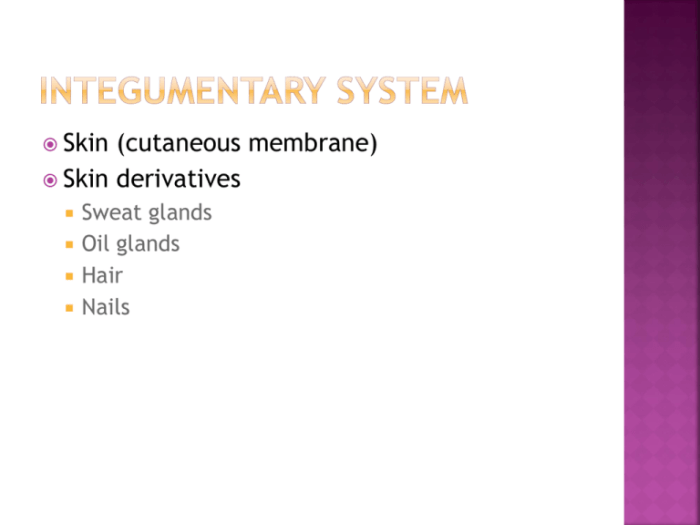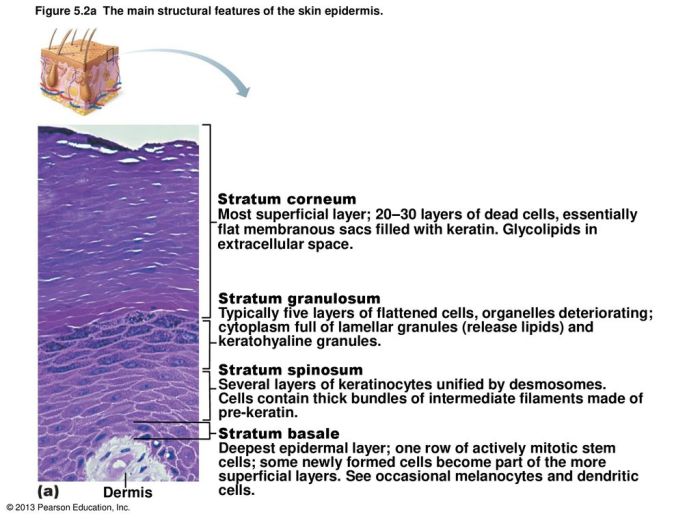The layer containing sacs filled with fatty material or keratin subunits, a fascinating component of the skin, plays a crucial role in various physiological processes. This introductory paragraph delves into the intriguing details of this layer, providing an overview of its structure, function, and clinical implications.
Adipose tissue, a primary component of this layer, consists of specialized cells called adipocytes, which store energy in the form of lipids. Keratinocytes, another cell type found in this layer, contribute to the formation of skin and hair, providing protection and insulation.
The subcutaneous layer, where this layer is located, serves as a protective barrier and facilitates essential functions such as thermoregulation.
Adipose Tissue

Adipose tissue, commonly known as body fat, is a specialized connective tissue that plays a crucial role in energy storage and insulation. It is composed of adipocytes, which are cells that contain a single large lipid droplet. Adipose tissue is distributed throughout the body, with significant accumulations in areas such as the abdomen, buttocks, and thighs.
Structure and Function of Adipose Tissue
Adipocytes are large, spherical cells that are packed together to form adipose tissue. Each adipocyte contains a single, large lipid droplet that occupies most of the cell’s volume. The lipid droplet is surrounded by a thin layer of cytoplasm and a cell membrane.
Adipocytes also contain a nucleus and other organelles, but these are often pushed to the periphery of the cell by the large lipid droplet.The primary function of adipose tissue is to store energy in the form of triglycerides. When the body needs energy, hormones such as insulin and glucagon stimulate the breakdown of triglycerides into fatty acids and glycerol.
These fatty acids are then released into the bloodstream and can be used by cells for energy production.In addition to energy storage, adipose tissue also plays a role in insulation. The lipid droplets in adipocytes act as insulators, helping to maintain body temperature.
Adipose tissue is particularly important for insulation in cold climates, as it helps to prevent heat loss from the body.
Keratinocytes

Keratinocytes are the primary cells of the epidermis, the outermost layer of the skin. They are responsible for producing keratin, a protein that gives the skin its strength and resilience. Keratinocytes also play a role in the formation of hair and nails.
Structure and Function of Keratinocytes
Keratinocytes are polygonal cells that are arranged in layers in the epidermis. The outermost layer of keratinocytes is composed of dead cells that are filled with keratin. These dead cells provide a protective barrier against the environment. The deeper layers of keratinocytes are living cells that are constantly dividing to produce new cells.Keratinocytes
produce keratin, a fibrous protein that is the main component of the skin. Keratin gives the skin its strength and resilience. It also helps to protect the skin from damage. Keratinocytes also produce other proteins, such as involucrin and filaggrin, which help to form the skin’s barrier function.
Subcutaneous Layer: Layer Containing Sacs Filled With Fatty Material Or Keratin Subunits
The subcutaneous layer, also known as the hypodermis, is the deepest layer of the skin. It is composed of adipose tissue, connective tissue, and blood vessels. The subcutaneous layer provides insulation and protection for the body.
Structure and Function of the Subcutaneous Layer
The subcutaneous layer is composed of adipose tissue, which is a type of connective tissue that stores energy. The adipose tissue in the subcutaneous layer helps to insulate the body and protect it from cold temperatures. The subcutaneous layer also contains blood vessels, which supply nutrients and oxygen to the skin and underlying tissues.The
subcutaneous layer is important for a number of clinical procedures, such as liposuction and injection procedures. Liposuction is a surgical procedure that removes excess adipose tissue from the body. Injection procedures, such as botox injections, are used to inject substances into the subcutaneous layer to improve the appearance of the skin.
Epidermis

The epidermis is the outermost layer of the skin. It is composed of keratinocytes, which are cells that produce keratin, a protein that gives the skin its strength and resilience. The epidermis also contains melanocytes, which are cells that produce melanin, the pigment that gives the skin its color.
Structure and Function of the Epidermis, Layer containing sacs filled with fatty material or keratin subunits
The epidermis is composed of four layers of cells: the stratum corneum, the stratum lucidum, the stratum granulosum, and the stratum basale. The stratum corneum is the outermost layer of the epidermis and is composed of dead cells that are filled with keratin.
The stratum lucidum is a thin layer of cells that is located below the stratum corneum. The stratum granulosum is a layer of cells that contains granules of a protein called keratohyalin. The stratum basale is the innermost layer of the epidermis and is composed of living cells that are constantly dividing to produce new cells.The
epidermis protects the body from the environment. The stratum corneum provides a physical barrier against bacteria, viruses, and other harmful substances. The stratum lucidum and stratum granulosum help to maintain the skin’s moisture levels. The stratum basale is responsible for producing new cells to replace the dead cells that are shed from the stratum corneum.
Dermis

The dermis is the middle layer of the skin. It is composed of connective tissue, blood vessels, and nerves. The dermis provides support and elasticity to the skin.
Structure and Function of the Dermis
The dermis is composed of two layers: the papillary layer and the reticular layer. The papillary layer is the outermost layer of the dermis and is composed of loose connective tissue. The reticular layer is the innermost layer of the dermis and is composed of dense connective tissue.The
dermis provides support and elasticity to the skin. The connective tissue in the dermis contains collagen and elastin, which are proteins that give the skin its strength and resilience. The blood vessels in the dermis supply nutrients and oxygen to the skin and underlying tissues.
The nerves in the dermis provide sensation to the skin.
FAQ Corner
What is the primary function of adipose tissue?
Adipose tissue primarily serves as an energy reservoir, storing lipids for later use by the body.
How do keratinocytes contribute to skin health?
Keratinocytes produce keratin, a protein that provides structural integrity and protection to the skin.
What is the clinical significance of the subcutaneous layer?
The subcutaneous layer is crucial for insulation, cushioning, and facilitating procedures such as liposuction and injections.